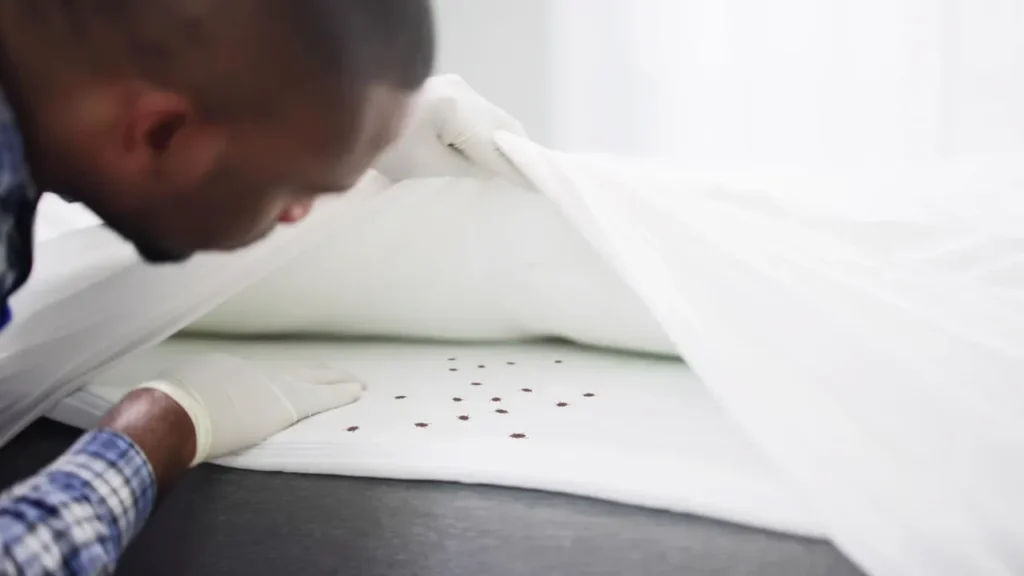Description
Bed bugs are tiny, wingless insects that are about the dimensions of a single apple seed. They are often active at nighttime and eat both animal and human blood. Bed bugs are a common pest in a range of places, including hotels, residences, and public transportation. These bugs can also be found in clean areas, but prefer to live in unclean environments or in areas of inadequate hygiene more frequently.
You May Also Like:
HOO RAA CBD VS PARTNERED PROCESS CBD
BIOSIMILARS: DESCRIPTION, CAUSES, AND TREATMENT PROTOCOL
Bed Bugs: Description, Causes, and Treatment Protocol is an original (HealthXWire) article.
Possible Causes
Bed bugs are frequently transported into space on infected goods like clothing, baggage, or furniture. They can also travel through electrical outlets, pipes, and walls to move between living spaces or apartments. Apartments, hotels, and dorm rooms are some more examples of places where bed bugs are frequently encountered. Homes can also become infested, especially in areas that are disorganized or neglected.
Exacerbating and Mitigating Factors
Numerous things, such as poor hygiene, crowding, along with the presence of various other pests, can make bed bugs worse. Furthermore, bed bugs are hard to get rid of after an infestation has been detected due to their rapid ability to spread.

Standard Treatment Protocols
The most common way to exterminate bed bugs is through an assortment of chemical as well as non-chemical measures. Depending on the extent of the pest infestation and the source of the issue location, a certain strategy needs to be used. A few of the treatment techniques are as follows:
Chemical Treatments: Insecticides are a chemical based tactic that is most commonly used to exterminate bed bugs. Chemical extermination destroys bed bugs upon contact or through ingestion and can be used in the form of a spray or a small particle of dust. The most commonly used insecticides for the treatment of bed bugs include organophosphates, neonicotinoids, pyrethroids, and pyrethrins.
Chemical treatments can only be carried out by a qualified pest control specialist since, if misused, they can be hazardous. Additionally, bed bugs are susceptible to gradually developing resistance to some insecticides, which makes it critical to use a variety of techniques to get rid of them effectively.
Non-Chemical Treatments: The use of non-chemical bed bug remedies is optional and they can be used along side chemical treatments. The following non-chemical remedies represent some of the more successful ones:
- Vacuuming
Bed bugs along with their eggs can be easily and successfully removed from affected regions by vacuuming. To stop the bugs from fleeing, it’s crucial to use a vacuum containing an HEPA filter as well as a removable airtight plastic vacuum bag
- Encasements
Pillows, mattresses, and box springs can be covered with bed bug-proof encasements to keep the bed bugs out. Such encasements can be readily removed and cleaned as necessary and are constructed of a bed bug-resistant material.
- Clutter Reduction
Decreasing clutter within your home can assist in minimizing the possibility of an infestation because bed bugs flourish in congested settings. Cleaning and your living area on a regular basis will help get rid of clutter and prevent infestations from forming.
- Steam Cleaning
Bed bugs, along with their eggs, can be eliminated with steam treatments upon surfaces including furniture, mattresses, and box springs. In order to guarantee that all of the bugs are destroyed, it’s crucial to use a steam cleaner that allows for temperatures over 120°F (49°C) and to direct the hot steam directly on the insects.
- Heat Treatments
Owing to their great sensitivity to heat, bed bugs can be destroyed by prolonged exposure to temperatures exceeding 120°F (49°C). A professional thermal treatment or the application of any portable bed insect heater can also accomplish this. Heat treatments, nevertheless, can be pricey and are not always appropriate.
- Cold Treatments
Bed bugs can be eliminated by placing them in a very chilly environment. This can be accomplished by freezing the bugs using carbon dioxide ice or by freezing the afflicted items in the freezer over a few days. Still, cold treatments tend to be cost-effective and might not be appropriate in all circumstances, comparable to heat treatments.
- Essential Oils
Bed bug repellent or insecticidal effects can be found in some essential oils, including tea tree, lavender, and eucalyptus oil. For protection against bugs, these oils can be mixed with a carrier oil and sprayed topically or through a diffuser.
- Silica Gel
An effective desiccant for drying out and eliminating bed bugs has been silica gel. It functions by absorbing moisture found in bugs, which dehydrates them. Silica gel can also be used as a spray.
- Natural Insecticides
Bed bugs can be exterminated by using a variety of natural insecticides, including pyrethrin and diatomaceous earth. Such products are made from natural ingredients and are usually regarded as safer than insecticides made from synthetic materials. In order to use these goods safely, you must pay close attention to the instructions provided by the manufacturer.


Treatment Options
The following additional extermination methods may be successful in getting rid of bed bugs besides the standard treatment protocols:
Prescription Medications: Antihistamines and topical corticosteroids are two examples of prescription drugs that may be administered to treat bed bug bite problems. While antihistamines are effective with swelling and redness reduction, topical corticosteroids can help with itching and inflammation reduction.
Over-the-Counter Medications: For the treatment of bed bug bites, over-the-counter products like hydro-cortisone cream and calamine lotion can be effectively used. These methods can be administered directly to the afflicted region and help relieve irritation and itching.
Natural Remedies: There are numerous organic treatments that might deter or get rid of bed bugs. These treatments can contain diatomaceous earth, essential oils like peppermint or lavender, or tea tree oil.
Herbal Remedies: Certain herbs, like thyme oil or neem oil, are being proven to be successful at fending off or getting rid of bed bugs. To ward off bed bugs, these treatments can be administered topically or can be diffused.
Nutritional Supplements: Certain nutritional supplements, like vitamin B1, can potentially ward off bed bugs, according to some research.
However, natural treatments and alternative therapies might be a better choice if you are allergic or are sensitive to specific chemicals. Since there have been growing concerns regarding the possible health risks posed by synthetic insecticides and pesticides, these substitutes have become more and more popular.
Diatomaceous earth constitutes one of the best all-natural treatments for bed insect infestations. This is a finely ground substance that was created from the fossilized remnants of diatoms, which are little aquatic organisms. Diatomaceous earth soaks up the wax as well as oil found in the exoskeletons of bed bugs once they come into touch with the substance, leading to their dehydration and eventual death.
Prevention
There are a variety of preventative steps that may be followed in conjunction with natural treatments and other therapies in order to reduce the possibility of problems like bed bug infestations. These consist of the following:
- Frequently checking used bedding, furniture, and clothing prior to bringing them inside the house.
- Putting bed bug-proof covers on all mattresses, pillows, and box springs.
- Refraining from buying secondhand box springs and mattresses.
- Using hot water to wash garments and applying high heat to dry bedding.
- Steam-cleaning and vacuuming furniture, floors, and other surfaces on a regular basis.
- Examining clothing and bags after a trip.
- Maintaining a clean living environment.


Conclusion
The likelihood of a bed bug invasion can be decreased by using good hygiene practices and maintaining clean, uncluttered living spaces. With routine vacuuming and cleaning, bed bugs and the eggs they lay can be removed from upholstered furniture, carpets, and other surfaces. It is also imperative to search for and seal any openings or cracks in the flooring or walls which could serve as bed bug entryways.


Additional resources for further reference
https://www.medicalnewstoday.com/articles/158065#causes
https://www.aad.org/public/diseases/a-z/bed-bugs-overview
https://www.cdc.gov/parasites/bedbugs/faqs.html
https://www.mayoclinic.org/diseases-conditions/bedbugs/symptoms-causes/syc-20370001
Important Note: The information contained in this article is for general informational purposes only, and should not be construed as health or medical advice, nor is it intended to diagnose, prevent, treat, or cure any disease or health condition. Before embarking on any diet, fitness regimen, or program of nutritional supplementation, it is advisable to consult your healthcare professional in order to determine its safety and probable efficacy in terms of your individual state of health.
Regarding Nutritional Supplements Or Other Non-Prescription Health Products: If any nutritional supplements or other non-prescription health products are mentioned in the foregoing article, any claims or statements made about them have not been evaluated by the U.S. Food and Drug Administration, and such nutritional supplements or other health products are not intended to diagnose, treat, cure, or prevent any disease.
Table of Contents


